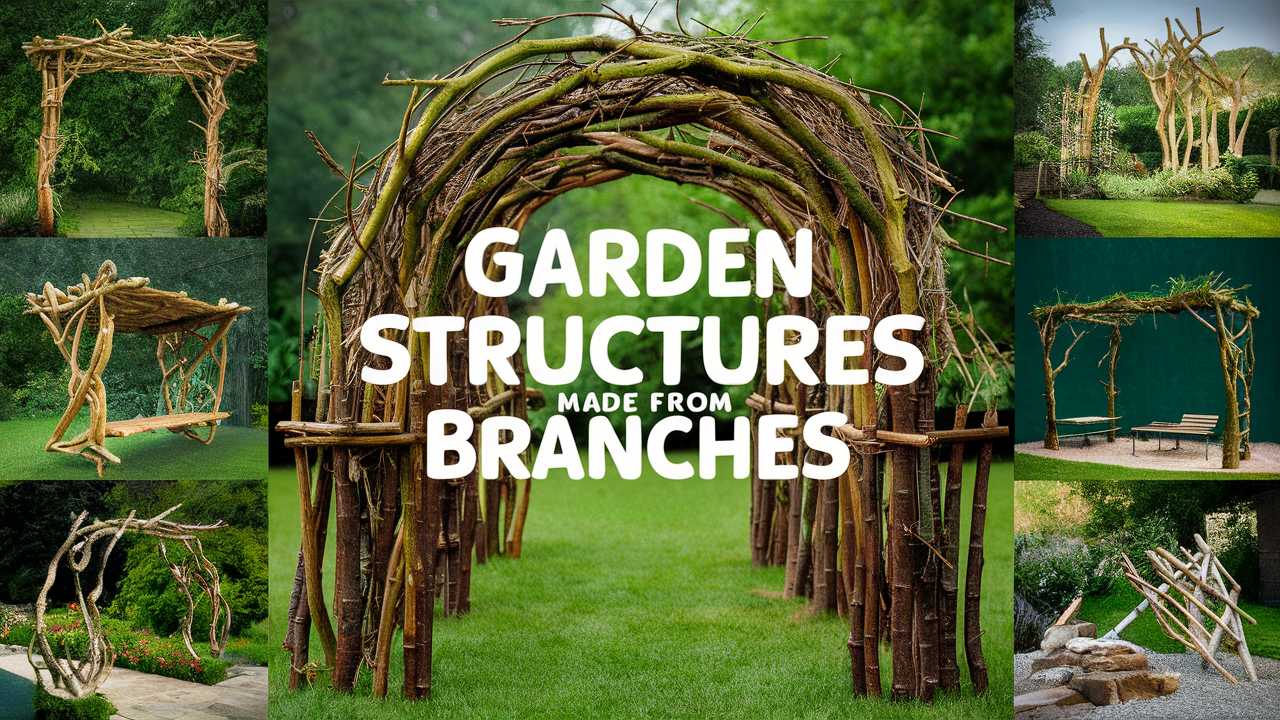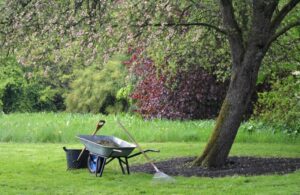In this post, we’ll explore the charming world of garden structures made from branches, exploring their benefits, types, construction methods, and ideas for integrating them into your garden design.
View this post on Instagram
Ever think about making a dreamy entrance to your garden? I love the natural feel of these woven branch archways – they create such a whimsical, almost fairy-tale vibe! You could use willow or any flexible branches and train climbing plants up them for an even more magical effect. It feels like stepping into another world and makes a pretty unique feature. If you add another behind it, that will make it like a magical fairy tunnel that leads you to your dreams.
View this post on Instagram
This little nook looks so inviting, doesn’t it? I love the idea of building a simple A-frame structure out of branches like this, just as a cozy little place to sit. The rustic look is really appealing, and I think it would be a fun project to build. Imagine adding some climbing plants to weave through the branches for extra charm, it could even host some seasonal decorations. It’s a great way to add some character to your garden.
View this post on Instagram
How about this woven willow tunnel? It’s such a cool idea for a garden path or even just a whimsical addition. I love how the light filters through the branches, making it feel like a magical little hideaway. Imagine lining it with flowers or creating a secret garden feel. Plus, it looks like a super fun DIY project, which I’m all about! I think this would look great in any garden really.
View this post on Instagram
How about building a cool dome structure like this one? It’s made by weaving willow branches which I think is just so magical. The best part is that it would feel like your own secret little hideaway. You could even make a couple of these and connect them with a tunnel! Imagine how great they will look when the climbing plants grow through the lattice!
View this post on Instagram
Here’s an idea that uses branches for a more natural garden feel! I love how they’ve used branches to edge this raised bed, it adds a nice rustic touch and creates a neat boundary. Plus, that branch trellis is perfect for climbing plants, adding height and interest. It’s a great way to incorporate natural materials into your garden design and give it a cozy, organic vibe without being too over the top! I think this could even work well for a container garden setup.
View this post on Instagram
How about something a little different? I’m really drawn to this raised bed planter; the woven base makes it feel so organic, blending right into the garden. The hoops are whimsical, maybe they could support climbing flowers, or just add a touch of sculpture. I think the design is super versatile; it really depends on where you put it, and what you want to grow! I just love its rustic, natural vibe.
View this post on Instagram
Oh, these branch towers are kinda neat aren’t they? I like how the different winding styles give them a slightly distinct personality. I’m thinking one of these would look so pretty with climbing vines weaving all around it, and maybe even a small fairy light string. You could totally customize these and build them to any height you like and really give your garden some handmade charm. I might try something similar this weekend!
View this post on Instagram
Here’s an idea that creates a super magical space, right? I love how it forms an enclosed area, almost like a secret hideaway. The interwoven branches create this beautiful, natural dome effect. Plus, imagine adding some fairy lights, and suddenly, it’s the most enchanting spot in your whole garden. Even the ground is special with the wood rounds set in fine gravels.
View this post on Instagram
This dome structure is such a simple yet beautiful addition to the garden, isn’t it? Imagine it covered in climbing roses or maybe even grape vines. It would make the sweetest little shady spot to sit and read. I love the added touch of the dark mulch around the base, it really makes the light branches pop. Plus, it helps define the space as something special, a little haven in your yard.
View this post on Instagram
Isn’t this little archway trellis design just the cutest? I love how simple it is, and those branches really add a rustic touch to the garden. This style would be super helpful for climbing plants, keeping them tidy, and out of your walkways. It’s a perfect way to add some height and visual interest to a smaller garden bed too, don’t you think? You could even paint the branches for a pop of color, just a thought.
View this post on Instagram
Here’s a thought: why not try something like this branch archway? It’s a really natural, rustic look, right? And it would be such a fun project to build yourself! I love the idea of adding little pops of color with some colorful flowers, or you could let climbing plants take over for a totally different vibe. A simple arch like this will make any garden feel a little more magical.
View this post on Instagram
Here’s a cool idea for a simple archway using branches, it’s got that rustic, natural feel. It’s sturdy but not too bulky, which is really nice. You could even plant climbing flowers at the base to grow up and over it. I can just see it framing a lovely tree or the entrance to a little garden path. The way the branches are arranged on top creates a really nice open roof too, right?
View this post on Instagram
I love the simplicity of this one! Imagine walking through your garden gate framed by a natural branch arch. It’s not super polished but the rough texture of the branches adds so much charm especially with that basket of colorful flowers. You could easily build something like this using branches you’ve pruned. Plus, how cute are those little mushroom decorations?! It’s a really lovely way to make your garden entrance feel special and totally one-of-a-kind.
View this post on Instagram
How about something like this for a touch of real whimsy? Imagine strolling through your garden and coming across this fantastic figure, seemingly lost in their music. I think that they would add a totally unexpected and creative bit of joy to any space. They almost look like they’re crafted from the very landscape around them. Maybe you could try something similar, a figure playing an instrument or just captured in a moment of quiet contemplation.
View this post on Instagram
Here’s a cute little branch trellis idea for a raised bed garden. I love how it combines the rustic branches with those simple wooden supports – it feels so natural and hand-made. It would be perfect for supporting climbing veggies like peas, cucumbers or beans. And that little solar light inside, so cute! It just looks like a fun, easy weekend project that would add a lot of charm to any garden!
Garden Structures Made From Branches: A Creative Guide to Natural Landscaping
Gardening is more than just planting flowers or vegetables; it’s an expression of creativity and a way to enhance the beauty of your outdoor space. One innovative trend that has gained popularity among garden enthusiasts is the use of natural materials, particularly branches, to create various structures that not only serve functional purposes but also bring an organic aesthetic to your garden. In this post, we’ll explore the charming world of garden structures made from branches, exploring their benefits, types, construction methods, and ideas for integrating them into your garden design.
The Allure of Natural Structures
Why would one choose branches over conventional materials like metal or plastic for garden structures? The answer lies in the unique characteristics and benefits that natural materials offer. Firstly, branches are often more environmentally friendly and sustainable than other construction materials, especially when sourced locally or repurposed from landscaping projects. By incorporating branches into your garden, you can reduce waste and embrace a sustainable approach to gardening.
Additionally, structures made from branches blend seamlessly into natural landscapes, enhancing the beauty of your garden without overwhelming it. They provide a rustic charm that hard materials can’t replicate, creating a warm, inviting atmosphere. If you’re looking to cultivate a peaceful retreat or a whimsical space, branch structures can transform your garden into a serene oasis.
Types of Garden Structures
Trellises
Trellises are an essential garden structure, especially for those looking to grow climbing plants like tomatoes, peas, or flowering vines such as clematis and honeysuckle. A trellis made from branches can be constructed in various shapes and sizes, depending on your garden’s needs. Imagine a simple archway adorned with climbing roses or a tall lattice design supporting fragrant beans, all crafted from beautiful, natural materials.
Arbors
Arbors are more than just support for climbing plants; they act as focal points that can enhance the design of your garden. Constructing an arbor from branches adds a sense of elegance and charm. You can create a natural entrance to a garden path or a cozy sitting area draped in the beauty of flowering vines. The interplay of light and shadow through the branches adds a dynamic element, making it a delightful place to relax.
Fences and Boundaries
Using branches to form fences or garden boundaries is a fantastic way to delineate spaces while maintaining a natural look. A woven branch fence adds an organic touch and can be particularly effective in rustic or cottage gardens. Not only do these fences provide privacy and security, but they also serve as habitats for small creatures, promoting biodiversity in your garden.
Garden Beds and Borders
Utilizing branches to form raised garden beds or borders is both practical and visually appealing. Branches can outline beds, providing clear definitions for planting areas while also enhancing the structure of your garden. Such designs allow gardeners to create tiered gardens or maintain soil moisture, reducing the need for excessive watering.
Compost Bins
Creating a compost bin using branches is an eco-friendly and resourceful solution for managing garden waste. By forming a simple structure with branches, you can house your compost materials while ensuring proper aeration and drainage. This structure not only uses discarded materials but also encourages the natural decomposition process, feeding nutrients back into your garden.
Gathering and Preparing Branches
Before you dive into building your structures, it’s crucial to consider how to gather and prepare your branches. Sourcing branches can be as simple as collecting fallen limbs from your yard or nearby parks, or you may choose to prune overgrown trees. Ensure that the branches you select are healthy, free from pests, and appropriate for the project at hand.
Types of Wood
Different branches serve different purposes in garden structures. Softwoods like pine and cedar are lightweight and easy to work with, making them suitable for temporary or movable structures. On the other hand, hardwoods like oak and hickory offer durability and strength, ideal for more permanent constructions. Additionally, consider the aesthetics of the wood; different species bring varying textures and colors that can enhance your garden’s overall look.
Cleansing and Preparing
Once you have your branches, it’s important to prepare them properly. Clean off any dirt, leaves, or insects to ensure the integrity of the wood. If you’re planning to treat the wood for longevity, applying a natural wood preservative can be beneficial. However, be cautious to choose eco-friendly products that do not harm beneficial organisms in your garden.
Sizing and Shaping
Cutting the branches to the appropriate size is essential before beginning construction. Use sharp tools for clean cuts and ensure that the lengths correspond to your design. If you plan to create intricate shapes or angles, consider shaping your branches by whittling or trimming. This process not only ensures functionality but adds artistry to your construction.
Building Your Structures
Now that you have gathered and prepared your materials, it’s time to assemble your structures. Building with branches can be a fulfilling and enjoyable project, either solo or with family and friends. Here’s a straightforward approach to constructing some of the structures mentioned earlier.
Constructing a Trellis
To make a simple trellis, start by setting two taller vertical branches into the ground as the main supports. These should be equally spaced to provide stability. Next, cut shorter horizontal branches, which you will attach in a spaced manner, creating a grid. Secure each horizontal branch with twine or thin wire to ensure they remain in place. If desired, you can create a triangular or arched design for additional aesthetic appeal.
Building an Arbor
For an arbor, begin by constructing a rectangular frame using four long, sturdy branches as vertical supports. Choose two additional longer branches to span across the top as the crossbeams. Once the frame is secured in place, you can weave smaller branches between the vertical supports for added strength and to create a more natural façade. Ensure that your arbor is anchored deeply into the ground to withstand heavy vines and weather conditions.
Creating a Rustic Fence
To form a rustic fence, decide on the length and height. Use vertically placed branches driven into the ground as posts. Then, weave flexible, thinner branches horizontally between the posts. This creates a charming, rustic appeal while allowing airflow and visibility through the fence. If you desire, you can stain or leave your fence natural to blend best with your garden.
Assembling a Compost Bin
Start by outlining the dimensions of your compost bin with four sturdy branches as vertical supports. Attach additional branches around the perimeter, leaving space to toss in waste items easily. Ensure there’s enough airflow to keep the composting process efficient. Consider designing a removable front panel made from twigs for easier access when turning or harvesting the compost.
Choosing the Right Plants
Integrating plants with your branch structures is vital to creating a harmonious garden space. The selection of climbing plants, flowers, and vegetables can transform your structures into living art forms. Here are some popular choices suited for trellises, arbors, and more.
Climbing Roses
Climbing roses are a classic choice for trellises and arbors, lending a lush and romantic feel to your garden. Their abundant blooms attract pollinators, making them a perfect pairing for natural structures. As they grow, they will intertwine beautifully with the branches, creating fragrant, vibrant displays.
Sweet Peas
For a garden filled with delightful scents, sweet peas are an ideal companion to your branch trellises. They grow quickly and offer charming blossoms in various colors, enriching any garden setting. Their delicate nature complements the rustic aesthetic of wooden structures.
Perennial Vines
Consider planting perennial vines like clematis or honeysuckle on your arbors. These hardy plants will return year after year, providing ongoing beauty and structure. With the right care, they can flourish, covering your constructed features in lush greenery and stunning flowers.
Maintenance and Longevity
Proper maintenance is crucial in ensuring the longevity of your branch structures. While branches can be incredibly durable, they do require some care to remain strong and beautiful over the years.
Regular Inspections
Periodically inspect your structures for any signs of decay, pests, or instability. Early detection allows for prompt repairs, which can save you time and money in the long run. Remove any dead or decaying branches promptly to maintain the structural integrity of your projects.
Seasonal Maintenance
Consider seasonal maintenance to prolong the life of your wooden structures. In the fall, remove any climbing plants that have died or become sparse to prepare them for winter. If your structures have been stained or treated, check for any needed touch-ups and apply additional treatments when necessary.
Keeping it Natural
While it may be tempting to use preservatives or treatments not in line with organic gardening practices, focus on natural solutions. If needed, use non-toxic sealers or wood treatments to protect your structures from the elements. Encourage a natural aging process that enhances the visual appeal of your gardens.
The Creative Potential of Branch Structures
Beyond functionality and sustainability, building garden structures from branches opens doors to creativity and personalized design. Each structure tells a story as it ages and interacts with surrounding plants and wildlife.
Artistic Interpretations
Experiment with artistic interpretations of traditional structures. Instead of a classic trellis, try abstract designs incorporating branching angles or shapes that mimic the natural landscape around your garden. Intricate weaving patterns can add an artistic dimension, making these structures a central focus of your garden.
Innovative Uses
Think outside the box when it comes to using branches! Consider decorative features such as birdhouses or nesting platforms. Use branches to create whimsical sculptures, natural seating areas, or even a rustic fence gate, inviting unique artistic expression within your green space.
Conclusion
Creating garden structures from branches encompasses a multitude of benefits, enhancing the beauty, functionality, and sustainability of your outdoor space. With their natural charm and rustic appeal, these structures allow you to express your creativity while connecting with the earth around you.





